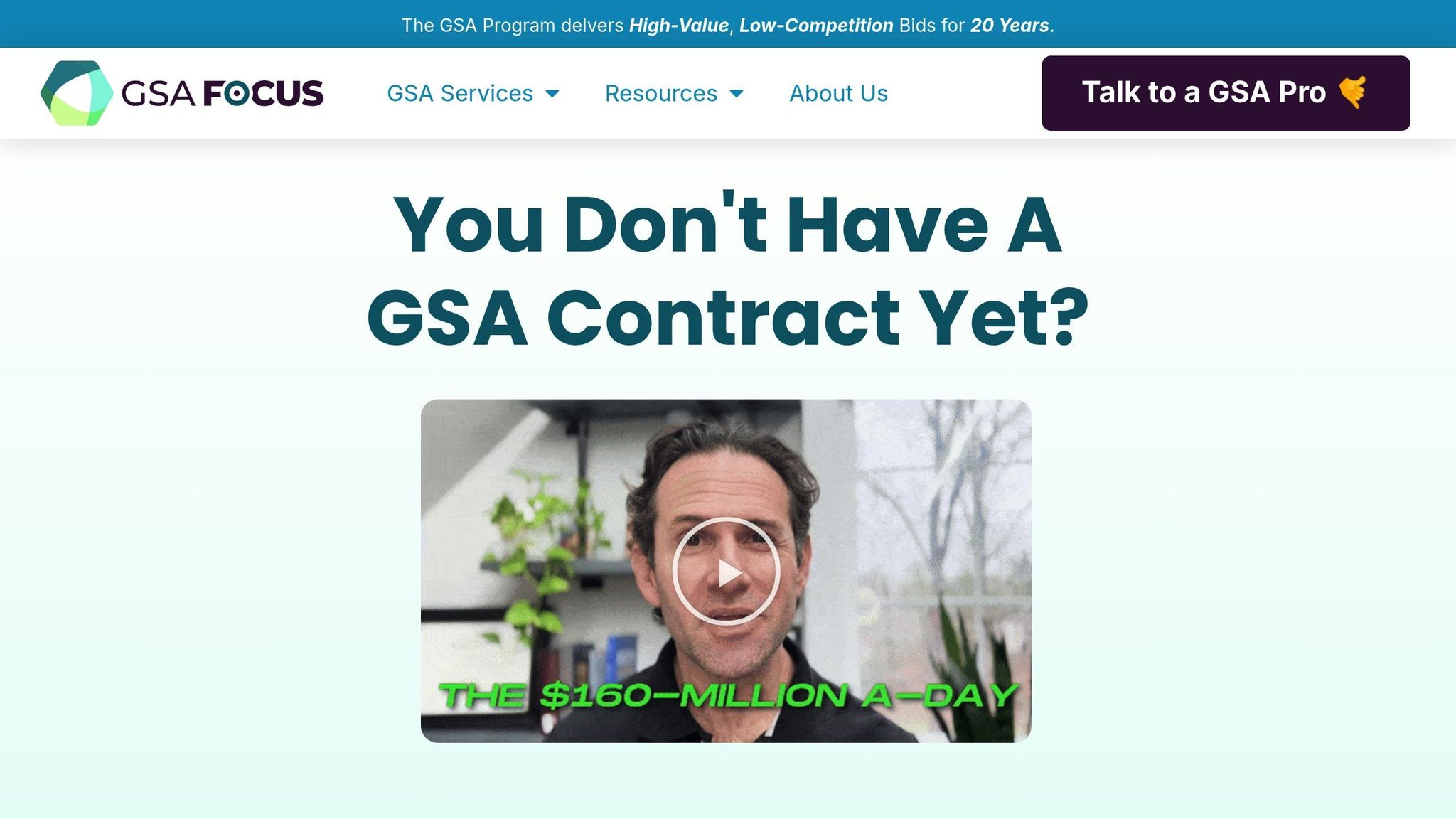GSA Schedule ordering is a simplified process for government agencies to purchase goods and services through pre-negotiated contracts. Here’s what you need to know:
- What is GSA Schedule? A long-term government contract that ensures pre-approved pricing and compliance for federal purchases.
- Why Use It? Faster procurement, reduced competition (44% of awards receive one bid), and consistent revenue for businesses ($927,000 annually on average).
- Who Can Use It? Federal agencies, state/local governments, tribal organizations, educational institutions, and select non-profits.
- Steps to Order:
- Get procurement authority (DPA).
- Select the right Schedule and Special Item Number (SIN).
- Research vendors using GSA eLibrary or GSA Advantage!.
- Write and send an RFQ to vendors.
- Review quotes, submit your order, and manage the contract.
Quick Tip: Only 4% of small businesses are part of this program, making it a less crowded market for those who qualify.
For more details on writing RFQs, evaluating vendors, and managing orders, continue reading.
Buying Services Through GSA Schedules – Basics of Buying …
Before Placing an Order
Getting Procurement Authority
If you’re a federal employee, you’ll need a Delegation of Procurement Authority (DPA) before placing an order through the GSA Schedule. This confirms you’ve completed the necessary training and understand GSA rules.
Here’s how to get your DPA:
- Complete the Federal Acquisition Certification (FAC) training.
- Submit your certification through the Federal Acquisition Institute Training Application System (FAITAS).
- Request the DPA from your agency’s procurement officer.
Your DPA level determines how much you can spend:
| Authority Level | Purchase Limit | Required Experience |
|---|---|---|
| Level 1 | Up to $25,000 | Basic FAC certification |
| Level 2 | Up to $250,000 | FAC + 2 years of experience |
| Level 3 | Unlimited | FAC + 4 years of experience + advanced training |
Make sure you have this authorization before moving forward with your purchase.
Finding the Right Schedule
Once you’ve secured your DPA, the next step is selecting the appropriate GSA Schedule. Picking the right Schedule and Special Item Number (SIN) is key to meeting your agency’s needs.
Steps for selecting a Schedule:
- Define your needs: Be clear about your agency’s requirements.
- Review Schedule categories: Match your needs with the relevant Schedule.
- Verify SIN alignment: Ensure the SIN covers the products or services you want.
- Check compliance: Make sure the Schedule meets any agency-specific rules.
Researching Vendors
After identifying the right Schedule, it’s time to evaluate vendors. Use platforms like GSA eLibrary and GSA Advantage! to gather information.
Key vendor evaluation criteria:
| Criteria | What to Check |
|---|---|
| Past Performance | Ratings and reviews from federal buyers |
| Pricing | Published rates and available discounts |
| Socioeconomic Status | Small business, veteran-owned, etc. |
| Geographic Coverage | Service areas and delivery capabilities |
| Contract Terms | Warranty, maintenance, and support options |
Be thorough in your evaluation. Look at contract terms, performance history (CPARS), current SAM.gov registration, technical capabilities, and response times. This ensures you select a vendor that meets your agency’s expectations.
5 Steps to Place a GSA Order
Writing Your RFQ
Creating a clear RFQ (Request for Quote) is key to successful GSA ordering. Your RFQ should include:
- Specific requirements and detailed specifications
- Criteria for evaluating vendor responses
- Start and end dates for the project
- Delivery deadlines
- Any special terms or conditions
Tips for crafting your RFQ:
| Element | Details |
|---|---|
| Statement of Work | Clearly define deliverables and expectations |
| Evaluation Factors | Consider price, technical ability, and past performance |
| Period of Performance | Include start/end dates and any optional extensions |
| Special Instructions | Outline submission format, deadlines, and Q&A procedures |
| Terms & Conditions | Cover payment terms, warranties, and acceptance criteria |
Once your RFQ is finalized, distribute it to potential vendors.
Sending RFQs to Vendors
Use GSA’s eBuy platform to share RFQs with Schedule contractors.
For orders over $10,000, send your RFQ to at least three qualified vendors. For those exceeding $250,000, ensure all vendors under the relevant SIN (Special Item Number) receive the RFQ. Allow at least 10 business days for responses. Be sure to document your vendor selection process for compliance.
Carefully review vendor responses based on your outlined criteria.
Reviewing Vendor Quotes
When vendor quotes come in, evaluate them thoroughly using technical reviews, price comparisons, and performance history.
1. Technical Review
Check how well each vendor’s proposal aligns with your requirements. Note their strengths and weaknesses.
2. Price Analysis
Compare proposed prices to GSA Schedule rates and general market prices. Pay attention to any additional discounts vendors might offer.
3. Past Performance
Look into each vendor’s performance history using CPARS (Contractor Performance Assessment Reporting System) and other sources.
After completing these evaluations, you’re ready to move on to submitting your order.
Submitting Your Order
To place your order, fill out the GSA Order Form (OF347 or SF1449). Include the following:
- Signed vendor quotes
- Documentation of price reasonableness
- Analysis showing best value
- Small business set-aside paperwork (if applicable)
Submit your completed form through your agency’s procurement system and keep copies for your records.
Checklist for required documents:
| Document Type | Purpose |
|---|---|
| Market Research | Explains why the GSA Schedule was chosen |
| Quote Analysis | Compares vendor quotes |
| Price Determination | Confirms prices are reasonable |
| Award Decision | Justifies the selected vendor |
| Funding Documents | Includes approved purchase requests and certified funding details |
sbb-itb-8737801
Rules and Requirements
Competition Rules
When placing GSA Schedule orders, you must follow specific competition guidelines. For orders valued between $10,000 and $250,000, you need at least three quotes from Schedule contractors. For orders over $250,000, all vendors under the applicable Special Item Number (SIN) must be considered.
| Order Value | Competition Requirements |
|---|---|
| Under $10,000 | Single quote acceptable (micro-purchase) |
| $10,000 – $250,000 | Minimum of 3 quotes required |
| Over $250,000 | Must consider all vendors under the relevant SIN |
| Set-aside orders | Only qualified small businesses can be included |
Once competition requirements are met, ensure pricing reflects fair market value.
Price Guidelines
Although GSA Schedule prices are pre-negotiated, vendors can offer extra discounts. To confirm price reasonableness, you should document your analysis using methods like:
- Comparing current GSA Schedule pricing.
- Negotiating volume discounts for large orders.
- Evaluating additional vendor concessions.
- Conducting market research on similar commercial items.
Your analysis should clearly show that the vendor’s pricing is fair and aligns with GSA Schedule rates.
Allowed Contract Types
After completing pricing analysis and evaluating vendors, choose the most suitable contract type. Options include:
- Firm-Fixed Price (FFP): A set total price for clearly defined deliverables. This is the preferred option for commercial items and services.
- Time and Materials (T&M): Requires justification, a ceiling price, and enhanced monitoring procedures.
- Labor Hour: Similar to T&M but excludes materials. It requires detailed definitions of labor categories and specified maximum hours.
Make sure to document your chosen contract type according to the provided guidelines.
Required Documentation
Maintain thorough records throughout the ordering process. Below are the key documentation requirements:
| Document Type | Key Requirements |
|---|---|
| Market Research | Provide rationale for selecting the Schedule |
| Competition Summary | List vendors contacted and their responses |
| Price Analysis | Include comparison methods and results |
| Best Value Determination | Explain why the selected vendor was chosen |
| Funding Documents | Include approved purchase requests |
| Small Business Documentation | Required for set-aside orders |
Keep all records in your contract file for at least six years after the final payment. This ensures compliance with federal acquisition regulations and supports any audits or reviews.
Managing Your Order
Order Management Tasks
Once you’ve placed your GSA Schedule order, keeping track of everything is essential. Here’s a quick breakdown of the main tasks:
| Task Type | Required Actions | Frequency |
|---|---|---|
| Vendor Communication | Track deliveries and address any issues | Weekly or as needed |
| Payment Processing | Review and approve invoices | Per payment schedule |
| Performance Monitoring | Record vendor performance, conduct quality checks | Monthly |
| Compliance Review | Ensure contract terms are being followed | Quarterly |
| Documentation | Update records with communications and changes | Ongoing |
Keep a close eye on vendor performance to ensure they meet the agreed terms. Maintain detailed records of communications and deliverables. Regular check-ins with the vendor can help address concerns early and keep the project on schedule. If any issues arise, adjust your order as necessary.
Making Order Changes
Sometimes, adjustments to your GSA order are unavoidable. Here’s how to handle changes while staying compliant:
1. Administrative Changes
These involve updates like billing details, contact information, or delivery schedules. Make sure changes are documented in writing and acknowledged by all parties.
2. Scope Changes
For larger changes that impact cost, quantity, or requirements, submit a formal modification request. Get the necessary approvals, adjust pricing or delivery terms, and update all related documentation.
3. Order Cancellations
If you need to cancel an order, inform the vendor immediately and provide written documentation. Be ready to cover any termination costs outlined in your contract.
Completing Orders
Once your order is managed and any changes are addressed, it’s time to wrap things up. Here’s what to check off during the closeout process:
| Completion Task | Requirements |
|---|---|
| Final Inspection | Ensure all deliverables meet specifications |
| Payment Review | Confirm all payments are correctly processed |
| Documentation Check | Verify the contract file is complete |
| Vendor Evaluation | Assess vendor performance |
| Close-out Report | Record final outcomes and any lessons learned |
Before making the final payment, confirm that all contract requirements have been fulfilled and any unresolved issues are addressed. Keep your contract file for at least six years after the final payment date, as required.
Next Steps
Quick Reference Guide
Here’s a handy guide for navigating the GSA ordering process:
| Phase | Key Actions | Important Considerations |
|---|---|---|
| Preparation | Verify procurement authority, identify schedule | Confirm eligibility and requirements |
| Research | Review vendors, compare offerings | Document your market research |
| Order Process | Write RFQ, collect quotes, evaluate responses | Follow competition rules |
| Management | Track deliverables, process payments | Keep detailed records |
| Completion | Conduct final inspection, close out contract | Maintain proper documentation |
Keep detailed records at every stage and stick to all GSA requirements. Regularly communicate with vendors and monitor deliverables closely to ensure everything runs smoothly. If you need expert help, the next section explains how GSA Focus can make the process easier.
GSA Focus Services

If GSA Schedule ordering feels overwhelming, professional help can simplify things. GSA Focus offers a done-for-you solution where you spend just 3 hours, while their team handles over 100 hours of work.
"We simplify the process by: We take all the ‘brain power’ out of getting an immensely profitable GSA contract. On average, you’ll only need 3 hours to give us what you need. And then… We do the other 100+ hours of work!" – GSA Focus
Their services cover document preparation, compliance checks, negotiation support, and contract management. With a 98% success rate and a refund guarantee, you can start your GSA journey with confidence. Schedule a free consultation to check your eligibility and get tailored advice on your next steps.
Related posts
- How to Read GSA Solicitation Documents
- GSA Schedules vs. Open Market Bidding
- GSA Award Process Explained
- GSA Contract Eligibility: Key Requirements


